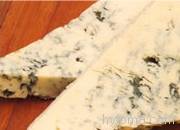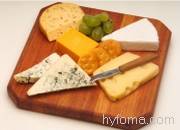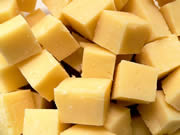 download article
download articleCheese
Article index
 | Process steps in making cheese |
Cheese is divided into different groups. Hard cheese, soft cheese and slicing cheese are defined on the basis of their water content. The exact definition is described in the FAO/WHO Standard A6, A7, A8.
Cheese production is a fermentation and coagulation process during which milk is concentrated. The main ingredients of cheese are casein (protein) and fat. The average ratio between the original milk and cheese is 10:1.
Process steps in making cheese
Since there are a great many different types of cheese, only the general process steps will be described here.In order to produce cheese, the milk is first standardized (fat and protein content are set) and sometimes pasteurized.
A number of ingredients should be added. First a small amount (120 ml/100 kg milk) of CaCl2 to provide the structure, then lactic acid bacteria to lower the pH and to give the specific taste of the used culture, sometimes a color agent is added to the milk for a darker yellow color of the cheese. The last ingredient in this phase is rennet.
Rennet is an enzyme which is present in calves' stomachs. It cuts the 'hairs' of casein, which leads to protein coagulation. This process is called curdling and lasts but 30 minutes. Only very small quantities of rennet are required in this case (30 ml/100 kg milk). Its effect is supported by a decreasing pH value caused by lactic acid fermentation.
Cheese makers use lactic acid bacteria, which are mesophilic (optimum: 25 to 40°C), thermophilic (up to 50°C) or mixed types depending on the type of cheese to be produced. The bacteria is either produced by the dairy itself in a pure culture or manufactured industrially by commercial companies. Pure cultures must be produced very carefully according to hygienic principles since the effect of a false culture can lead to substantial product losses. The culture can be added to the milk via fully automated metering systems en route to the maturing tanks or cheese producer or can also be placed in the tank. The CO2 produced during fermentation is responsible for the holes in cheese.
After the curdling process, the jelly (called curd) is cut and the cut is stirred. The stirring provides the jelly parts to contract and pull whey out of themselves. The released whey is first removed. Some cheese types require heat treatment and/or warm water. When the whey gets out of the curd, the lactose- and water concentration of the jelly parts decreases. At a lower concentration of lactose the growth of the lactic acid bacteria declines and avoids that the pH drops too much. For some types of cheeses nitrate (NaNO3) is added. Nitrate is slowly transformed into nitrite by the enzyme xanthine-oxidase. Nitrite prevents the germination and growth of spores or butyric acid bacteria
With the added water a second whey amount is let off. The most common used way is to drain the curd by a sieve. The left curd is put in a form.
The curd is then pressed in a form and drained in order to remove all the remaining whey (< 2%).
A salt content of between 0.5% and 2% is applied to the cheese. This process is carried out either dry or in a brine bath. The brine in a brine bad is adjusted to pH 4.5 - 5.0 with 18%-23% NaCl solution and is kept at a temperature of between 12 and 15°C. Salting removes additional whey from the cheese and strengthens the structure of the casein. The duration of the brine bath depends on the type of cheese, this varies from a few hours to a few days.
The cheese is washed and stored. In order to prevent excessive water loss and to avoid external micro-organisms, the cheese is often coated with paraffin or plastic (contains enzymes like natamycine or pimaricine to decrease yeast growth). The amount of lactose and protein in cheese is reduced during storage by riping caused by the remaining lactic acid bacteria activity The temperature and humidity must be matched precisely to the cheese type varying in temperature from 12 to 20°C and in humidity from 70 to 95%. The storage time lasts from a weeks to several months.
 back to top
back to top






 companies
companies




